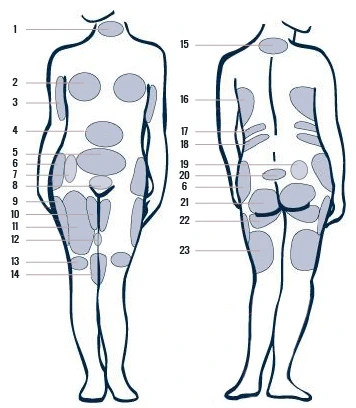Lipomatic surgery in Iran is a cutting-edge, minimally invasive technique used for body sculpting and fat removal. Leveraging advanced technology, it offers precise fat elimination with reduced pain and quicker recovery times compared to traditional liposuction methods. Iran has become a popular destination for this surgery due to its skilled specialists, state-of-the-art medical facilities, and cost-effective services, attracting patients globally seeking high-quality cosmetic procedures.
what is lipomatic surgery
Lipomatic surgery is a cutting-edge cosmetic procedure designed for effective fat removal and body sculpting, distinguishing itself from traditional liposuction through its use of vibrational energy to break down fat cells before removal. This technique ensures a more precise and less invasive process, significantly reducing the trauma to surrounding tissues.
Its efficiency in targeting localized fat deposits allows for smoother contours and a more natural-looking result, making it a popular choice for individuals looking to enhance their body shape without the lengthy recovery times and risks associated with conventional liposuction methods. One of the key advantages of lipomatic surgery is its ability to provide immediate visible results with minimal discomfort and downtime.
Patients can typically return to their daily activities shortly after the procedure, benefiting from its less aggressive approach and reduced risk of complications such as swelling and bruising. Furthermore, the procedure’s ability to stimulate collagen production leads to tighter, more toned skin in the treated areas, offering a dual benefit of fat reduction and skin tightening.
This innovative approach to body contouring has made lipomatic surgery a sought-after solution for those aiming for a more sculpted and aesthetically pleasing body silhouette.

different types of lipomatic
Lipomatic surgery, as a method of fat removal and body contouring, does not inherently come in “different types” in the same way that broad categories of surgery might. Instead, the technique itself is highly specialized and consistent in its approach, utilizing vibrational energy to emulsify fat before it is removed from the body.
In recent years, cosmetic surgery has witnessed remarkable advancements, and one such innovation that has gained immense popularity is lipomatic. Lipomatic is a minimally invasive body contouring procedure that has revolutionized the way people achieve their desired body shape. Iran, known for its medical tourism and skilled plastic surgeons, has become a leading destination for lipomatic procedures.
However, the application of lipomatic technology can vary based on the targeted area of the body or the specific goals of the patient. For example, lipomatic can be used for detailed sculpting in areas like the abdomen, thighs, arms, back, and even more delicate regions such as the neck and face. Each application area can require a slightly different approach in terms of the cannula used and the technique applied to achieve optimal results.
Moreover, advancements in lipomatic technology and technique can lead to variations in how the procedure is performed, aiming to enhance patient comfort, reduce recovery time, and improve outcomes. Some practitioners may combine lipomatic with other procedures such as fat transfer, where fat removed during lipomatic surgery is purified and re-injected into areas where volume enhancement is desired, such as the buttocks or facial features.
This holistic approach to body contouring allows for a wide range of customized solutions tailored to meet individual patient needs, making the most of the versatile and effective lipomatic technique.

Buttock lipo
Buttock liposuction is a cosmetic procedure aimed at reshaping and contouring the buttocks by removing excess fat deposits to create a more aesthetically pleasing and proportionate silhouette. This technique allows for targeted sculpting of the buttock area, enhancing its shape and size according to the patient’s desires and the surgeon’s recommendations.
Utilizing advanced liposuction methods, such as tumescent or ultrasonic-assisted liposuction, surgeons can precisely remove fat, minimize trauma to surrounding tissues, and ensure smoother recovery. Post-procedure, patients can expect a more defined buttock contour with results that are visible almost immediately, although the final outcome will become more apparent as swelling decreases over the following months.
Improved Contour
Buttock liposuction can enhance the shape and contour of the buttocks, creating a more sculpted and proportionate appearance.
Reduced Fat Deposits
The procedure targets stubborn fat deposits in specific areas of the buttocks that may be resistant to diet and exercise.
Enhanced Confidence
By achieving a more attractive buttock contour, patients may experience a boost in self-confidence and body image.
Abdominal lipo
Abdominal liposuction is a popular cosmetic procedure designed to remove stubborn fat deposits from the abdomen, resulting in a flatter and more toned stomach. This procedure targets areas that are often resistant to diet and exercise, such as the lower abdomen and love handles, allowing for precise contouring and enhancement of the waistline.
Abdominal liposuction can dramatically improve the appearance of the midsection, offering patients a more sculpted and aesthetically pleasing abdominal profile. Recovery typically involves wearing a compression garment to reduce swelling and support the healing tissues, with most patients returning to their normal activities within a few weeks, while observing a gradual. improvement in their contour as swelling subsides. Any potential risks or recovery details.

Facial lipo
Facial liposuction is a cosmetic procedure tailored to refine and rejuvenate the facial silhouette by removing excess fat from specific areas such as the chin, neck, and jawline. This targeted approach allows for the enhancement of facial contours, reduction of double chins, and a more defined neck and jawline, contributing to a younger and more harmonious facial appearance.
The procedure is minimally invasive, with recovery times shorter than those for more extensive surgeries, and results in a subtle yet impactful rejuvenation. Patients often report increased confidence and satisfaction with their appearance, as facial liposuction provides a natural-looking reduction of facial fullness and an overall more balanced and aesthetically pleasing facial structure.
Post lipo surgery Recovery
Post-liposuction recovery is a critical phase that significantly influences the outcome and satisfaction with the procedure. Immediately following liposuction, patients can expect to experience swelling, bruising, and discomfort in the treated areas. To manage these symptoms and facilitate healing, surgeons typically recommend wearing compression garments for a period ranging from a few weeks to a couple of months.
These garments help reduce swelling, contour the body, and decrease the risk of fluid accumulation. Pain and discomfort are usually controlled with prescribed or over-the-counter pain relievers. It’s important for patients to follow their surgeon’s advice closely during this time, including any specific instructions on care for incision sites, to ensure optimal healing.
Recovering from liposuction surgery is a crucial phase that requires patience and adherence to post-operative instructions to ensure optimal results and minimize complications. Here’s a detailed overview of the typical recovery process after liposuction surgery:
Immediate Post-Operative Period (First Few Days)
- Rest and Recovery: Patients are advised to rest for the first few days following surgery to allow the body to heal. Avoiding strenuous activities, lifting heavy objects, and bending over can help prevent complications and promote proper healing.
- Compression Garments: Wearing compression garments as instructed by the surgeon is essential to minimize swelling, promote blood circulation, and support the newly contoured areas. These garments should be worn consistently for the recommended duration, typically several weeks following surgery.
- Pain Management: Discomfort, soreness, and mild pain are common after liposuction surgery. The surgeon may prescribe pain medication or recommend over-the-counter pain relievers to manage discomfort during the initial recovery period.
- Monitoring Drainage: If drains were inserted during surgery to remove excess fluid and blood, patients will need to monitor and empty them regularly as instructed by the surgeon.
- Hydration and Nutrition: Staying hydrated and consuming a nutritious diet rich in fruits, vegetables, lean proteins, and whole grains can support the body’s healing process and promote recovery.
First Week
- Follow-Up Appointment: Patients typically have a follow-up appointment with the surgeon within the first week after surgery to assess healing progress, remove any sutures or dressings, and address any concerns or questions.
- Gentle Movement: While rest is crucial during the initial recovery period, light walking and gentle movement can help prevent blood clots and promote circulation. However, patients should avoid vigorous exercise and activities that strain the treated areas.
- Swelling and Bruising: Swelling and bruising are common after liposuction and may peak within the first few days before gradually subsiding. Elevating the treated areas and applying cold compresses can help reduce swelling and discomfort.

lipomatic after care
After undergoing liposuction, proper aftercare is crucial for optimal healing and achieving the desired results. Here’s a detailed guide on liposuction aftercare:
Compression Garments
- Wear as Directed: Your surgeon will provide compression garments to minimize swelling and support the treated areas.
- Follow Instructions: Wear the compression garments as instructed by your surgeon, typically around the clock for the first few weeks and then during the day for a few more weeks.
Wound Care
- Keep Incisions Clean: Follow your surgeon’s instructions for cleaning your incisions to prevent infection.
- Change Dressings: Change dressings as directed by your surgeon.
- Monitor for Infection: Watch for signs of infection such as increased pain, redness, warmth, or drainage from the incisions.
Pain Management
- Take Medications as Prescribed: Take prescribed pain medications as directed by your surgeon to manage discomfort.
- Ice Packs: Applying ice packs to the treated areas can help reduce swelling and discomfort.
Activity Restrictions
- Limit Activity: Avoid strenuous activities and heavy lifting for several weeks following liposuction.
- Gradual Return to Normal Activities: Gradually resume normal activities as directed by your surgeon.
Hydration and Nutrition
- Stay Hydrated: Drink plenty of water to aid in the healing process.
- Healthy Diet: Eat a balanced diet rich in nutrients to support healing.
Follow-up Appointments
- Attend Follow-up Visits: Attend all scheduled follow-up appointments with your surgeon for evaluation of your healing progress.
Scar Care
- Scar Management: Follow your surgeon’s recommendations for scar management, which may include scar creams or silicone sheets.
Monitor for Complications
- Watch for Signs of Complications: Keep an eye out for signs of complications such as excessive swelling, persistent pain, or changes in skin color.
Patience
- Be Patient: Results of liposuction may take several weeks to months to fully develop. Be patient and follow your surgeon’s advice for best results.
Mental Health
- Stay Positive: Maintain a positive outlook and communicate any concerns or anxieties with your surgeon or a mental health professional if needed.

Conclusion
Lipomatic surgery in Iran has established itself as a beacon for those seeking advanced and safe cosmetic procedures at a fraction of the cost found in many Western countries. The combination of highly skilled surgeons, who are well-versed in the latest body sculpting techniques, and the availability of cutting-edge medical facilities has positioned Iran as a leading destination for lipomatic surgery. Patients from around the globe are drawn not only by the affordability but also by the high standards of care and the personalized attention they receive, making their medical journey both comfortable and reassuring.
The success of lipomatic surgery in Iran is also attributed to the meticulous attention to detail and the personalized care plans developed for each patient. The procedure itself is celebrated for its effectiveness in fat removal and body contouring, offering results that are both immediate and long-lasting. The minimal invasiveness of the technique ensures that recovery times are significantly shorter, with patients able to resume their daily activities much sooner than with traditional liposuction, all while experiencing less discomfort and fewer side effects.
In conclusion, the popularity of lipomatic surgery in Iran reflects a broader trend towards seeking high-quality, cost-effective medical treatments abroad. Iran’s commitment to excellence in cosmetic surgery, combined with its welcoming approach to international patients, ensures that those opting for lipomatic surgery in the country are not only investing in their physical appearance but also in an experience that is safe, reliable, and satisfying. This blend of professional expertise, advanced technology, and exceptional patient care continues to affirm Iran’s status as a preferred choice for cosmetic procedures on the global stage.
common questions
1. What is Lipomatic Surgery?
Lipomatic surgery is an advanced form of liposuction that uses a specialized cannula with a vibrating tip to break down fat cells before they are suctioned out of the body. This technique allows for more precise fat removal with less trauma to the surrounding tissues, resulting in smoother outcomes, reduced pain, and quicker recovery times compared to traditional liposuction.
2. How does Lipomatic Surgery differ from traditional Liposuction?
The main difference lies in the technology used. Lipomatic surgery utilizes a vibrating cannula that facilitates the emulsification of fat, making it easier to remove. This method is less invasive, causes less bruising and swelling, and allows for a more controlled and precise sculpting of the body. Traditional liposuction relies on physical force to break up fat, which can be more traumatic to the body.
3. What are the benefits of Lipomatic Surgery?
Benefits of lipomatic surgery include reduced trauma to the body, leading to less pain and swelling post-operation, and a quicker recovery period. The precision of the technique allows for enhanced body contouring results, and the procedure can stimulate collagen production, leading to tighter skin in the treated areas. It’s also effective in removing localized fat deposits that are resistant to diet and exercise.
4. Who is a good candidate for Lipomatic Surgery?
Good candidates for lipomatic surgery are individuals who are close to their ideal body weight but struggle with localized fat deposits that do not respond to diet or exercise. Patients should be in good overall health, have realistic expectations about the outcomes, and possess good skin elasticity. It’s important for candidates to undergo a thorough evaluation by a qualified surgeon to determine their suitability for the procedure.
5. What is the recovery process like after Lipomatic Surgery?
The recovery process after lipomatic surgery is typically quicker and less painful than traditional liposuction. Most patients can return to their normal activities within a few days, though they may be advised to avoid strenuous exercise for a few weeks. Swelling and bruising are minimal and usually subside within a week or two.
Patients are often required to wear a compression garment for a certain period to help with the healing process and contouring of the body. Follow-up visits with the surgeon are necessary to monitor the recovery process.


